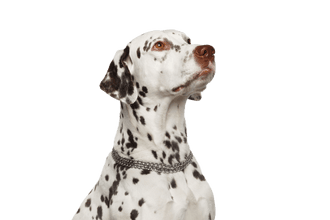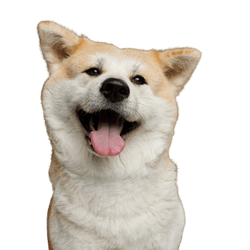
Dalmatian Breed description: Character & Co
Dalmatian
Facts & Origin
Features of the Dalmatian at one glance
The Dalmatian, also called Dalmatinac (Croatian), is a dog breed recognised by the FCI - Fédération Cynologique Internationale. It originates in Croatia and belongs to the group of scent- and blood hounds (FCI group 6, section 3, standard no. 153). The Dalmatian is a medium-sized to large dog with a well-proportioned, strong build. A Dalmatian male measures 56cm - 62cm in height on average and weighs between 27kg and 32kg. The shoulder height of females is about 54cm - 60cm in height. Dalmatian females reach an average weight of 24kg - 29kg. The Dalmatian has short, smooth and shiny fur. It is characterised by its typical black or brown spots. The Dalmatian has a life expectancy of 12 to 14 years.
Origin and history of the Dalmatian
The origin of the Dalmatian is still unknown today. Dalmatian-like images date back to Greek antiquity and the early Pharaonic period in Egypt. There are several theories about its origin. One of these theories states that the Dalmatian originates from Croatia (Dalmatia). Other possible countries of origin could be Italy, England, Turkey or Northern India.
In the late Middle Ages, the Dalmatian became very popular in European aristocratic houses and in aristocratic society in general. In England, it was mainly used as a companion dog for carriages. In the 19th century, it also served the American fire brigade as a living siren, protecting the fire engines, which were still pulled by horses at that time, from wild dogs. Therefore, the Dalmatian became the mascot of the New York fire department.
The origin of its name is as unclear as the origin itself. However, one theory is derived from the thought that the Dalmatian comes from the Croatian coastal region of Dalmatia.




| Alternate Name | Dalmatinac |
| Origin | Croatia |
| Life expectancy | 10 - 13 years |
| Care requirements | low-maintenance |
| Activity level | average to high |
| FCI group | Related breeds |
| AKC group | non-sporting group |
| KC group | utility group |
Dalmatian mixes
Attitude, character and temperament of the breed
Characteristics of the Dalmatian
Dalmatians are known for their friendly and lovable nature worldwide. They are considered to be lively family dogs, which is based on their open nature. The Dalmatian is considered to be particularly sensitive and attentive towards people. It reacts predominantly friendly towards other dogs too and aggressive behaviour can only be observed in very rare cases. This type of dog is not suitable for strict training under pressure and forcefulness. Depending on the situation, Dalmatians can also show characteristics of guard dogs. It has a mind of its own and may appear somewhat stubborn at times. Although the Dalmatian has not been officially kept as a hunting dog, it shows certain behaviours of hunting dogs. With a loving and consistent training, letting your dog run off the leash is not a problem with this breed of dog.
The Dalmatian needs a lot of exercise to be balanced. The minimum time a day spent doing activities with them outdoors is two hours, but three to four hours of daily exercise is recommended. The Dalmatian's urge to move is due to the fact that Dalmatian breeding focuses on the dog's ability to run at a consistent high speed. A Dalmatian is the perfect dog for dog sports, such as cycling, agility, clicking, search games or dog dance. It also loves ball games and retrieving objects both on land and on water. Leisurely activities, such as jogging or horse riding with a Dalmatian as a companion dog, are also perfect for them.
As already described above, when keeping a Dalmatian, its high drive to move should be taken into account. Only with a lot of outdoor exercise, an appropriate keeping of this breed of dog can be provided. If you would like to buy a Dalmatian, you should be aware of their pronounced instinct to move and estimate exactly whether you will be able to give your dog what it needs to stay healthy in everyday life.
The Dalmatian is a humorous and adaptable companion and family dog. Because of its sensitive nature, close family connections that are made by giving them enough attention and sufficient exercise are especially important. Its short and thin coat makes the Dalmatian unsuitable for outdoor keeping.
Character
Usage





Health and breeding information
Typical diseases of the Dalmatian
Among the typical Dalmatian diseases there are
- Deafness
- Dalmatian Syndrome
- Dalmatian Leukodystrophy
- Immunodeficiency
- Allergies
Nutrition of the Dalmatian
Since Dalmatians have a breeding-conditioned disturbed uric acid transport system, their diet should be low in purine. Fish, yeast and innards are the types of foods that should therefore not be on their menu too often. This way, this disease can be prevented in everyday life. When keeping a Dalmatian, it can be very useful to draw up a special diet plan together with your veterinarian, so that typical Dalmatian allergies and immune deficiencies can be considered too. Prophylactic foods contain Omega 3 and Omega 6, such as rapeseed oil.
Buying Dalmatians
The purchase of a Dalmatian must be well thought through. Beforehand, it should be carefully considered whether the active dog fits into your way of living. If you are looking for a Dalmatian puppy, you should ask a local breeder from a reputable breeding association. It is also important to be aware of the possible diseases and the sensitive character of this dog breed. A Dalmatian puppy costs 1400 Euros.


Special features and interesting facts about the Dalmatian
Dalmatian puppies are born with white fur. Only after 10 to 14 days the first black or brown spots become visible. After that, they multiply until their first year of life is complete. In some cases it is possible that a Dalmatian is already born with isolated large spots. These spots are called plates and are still a breeding exclusion criterion today.
Dalmatians are more likely than other dogs to become deaf. This strange characteristic is genetically determined. So far, the responsible gene for this could not be discovered, but a connection with the white part of the Dalmatian's coat is suspected.
Since the Dalmatian does not shed a lot of hair, this dog breed is more suitable for allergy sufferers than long-haired dog breeds.
| Fur length | short |
| Fur | flat coated |
| Ear shape | Triangle |
| Tail | lang |
| Anatomy | sporty |
| Size ♀ | 56 - 58 cm |
| Weight ♀ | 16 - 24 kg |
| Size ♂ | 58 - 61 cm |
| Weight ♂ | 16 - 24 kg |
| Suitable For | - |
Colors





Known Diseases
Allergies
Can occur in a number of breeds, regardless of genetic makeup.
Numbness
Often occurs in old age.
FAQ
-
Yes, Dalmatians are very active family dogs.
-
A Dalmatian requires consistent training and is eager to learn.
-
No, the Dalmatian serves more as a companion dog and running dog.
-
A Dalmatian puppy costs 1400 Euro.
Other large dogs
Useful Articles
You can find articles that might interest you in the dogbible blog to match your favorite breed.
Visit our magazineto stay up to date on dog trends.
To find out more, view our Privacy Policy
Find here the breed that suits you and find out what character traits it has. Here you can also learn more about the origin, size and weight of your favorite breeds.
Matching your favorite breed, you'll find articles that might interest you on the dogbible dog blog.
Dog Eats Dirt: We Know Why he eats soil
This genius hack to trim your dog’s nails and more tips

























